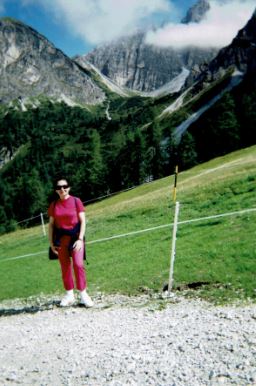by Maria Teresa De Donato, Ph.D., Life Strategist

“A journey of a thousand miles begins with a single step,” stated Lao-Tzu sometime between the 5th and the 4th century B.C. Though one might think at first that’s like stating the obvious, the reality is that for so many among us, sometimes it appears that moving just one step forward in one direction or the other is hard when not even impossible to accomplish. How so?
I am not a sportive person. I have been, however, always quite agile and active one way or the other all my life. Though I am not particularly interested in the gym – I like fresh air and enjoying a beautiful landscape much more than exercising indoors – I always preferred to walk, hike and swim whenever possible. Every time I happen to be around mountains, for instance, I take the opportunity, either on my own or with friends, to go up to the top. This happened to me many times in the Alps.
One day I was with a friend. I knew she was not accustomed to the mountains nor very inclined to do any form of exercise either. However, since she appreciated the breathtaking alpine landscape, I suggested we take a walk and see how far up we might go. We didn’t walk but a mile or so, including no more than 500 meters (0.31 miles) of an uphill road in the woods, for as soon as she saw the upward slope of the lane, she came up with all sorts of justifications – “rational and logical explanations” in her view – in order not to proceed any further.
Although since the start, I had been aware that we would not have reached the top of the mountain that day but most likely stopped much sooner, it was pretty evident to me that it was my friend’s mental blockage preventing her from moving ahead and making any progress. My attitude was a positive one: I suggested we would forget all about reaching the top and not focus on the evident upward slope which appeared to our very eyes but rather concentrate on the fact that all we needed was to move one step forward at a time and that when she would feel tired, we would stop for a few minutes and see whether to continue or to turn around and start descending.
In my view, however, my friend, to the contrary, gave up before starting: she convinced herself, by keeping repeating it, that it was too much for her – and we weren’t but only ten minutes into the woods compared to the two hours and forty minutes usually expected to reach the top – that the upward slope was excessive, that she would have probably fallen or gotten sick and whatever still left in between.
In our everyday life, my friend’s attitude in that circumstance is more frequent than one might imagine. How many among us are stuck in a situation, in a depressing and, maybe, underpaid job, or in a frustrating, unloving, mentally, emotionally, and, perhaps, even physically abusive relationship where we feel trapped, do not know what to do next and how, and what direction eventually we should take? Sometimes it is not a matter of lack of possibilities but a lack of positive, constructive thinking and consequent audacity, fear of the unknown, what might happen if we try, and fear of failure.
Possibilities are all around us, and all that is required is to start moving, one step at a time, doing something new, something different we have never tried before. Failures and obstacles we may encounter on our path are there for a reason: to make us grow, to refine and strengthen ourselves, our beliefs, our ability, and our determination to get closer to our final goal or to point in a new direction we should take in our life.
Too often, we might choose between two or more opportunities at once. We need clarification, feel uncomfortable, and wonder which way to go. We feel insecure about what choice to make. The reality is that one direction might be as valid as the other one and that the Universe, Life, God, or however we want to call It/Her/Him, is just offering us more than one possibility to choose from. It is really up to us which way to go. We need to get started.
Fear is, unfortunately, the most common element in people’s life. Fear keeps us prisoners of ourselves. Fear of failure prevents most of us from reaching our full potential. However, once we accept the possibility that we can fail, that a loss does not determine who we are, and we do not allow it to interfere with or even compromise our self-esteem, we will start taking control over our lives.
Write down where you are and where you want to be in the future, in the next three or six months, a year, or ten years and make a list of things you can do to reach that goal. Move one step forward at a time but be consistent. And should life at a certain point indicate that you need to change direction, do not get frustrated or discouraged. You won’t have “lost” anything. The time, money, and energy you will have invested so far will have made you who you are, and all that you have learned will serve you – one way or the other – to accomplish whatever you have in mind.
Things happen for a reason, and all the knowledge and experience you will have acquired will serve their purpose and remain with you all your life. Even if you, in the meanwhile, have changed direction and started walking a different path, everything you will have treasured so far will prove to be helpful at a certain point in time and maybe even when less expected.
Let’s get started then, and remember: Move just one step at a time. Ignore the “upward slope” and focus on your very next step. That’s all you need to do.
Maria Teresa De Donato©2015-2023. All Rights Reserved

